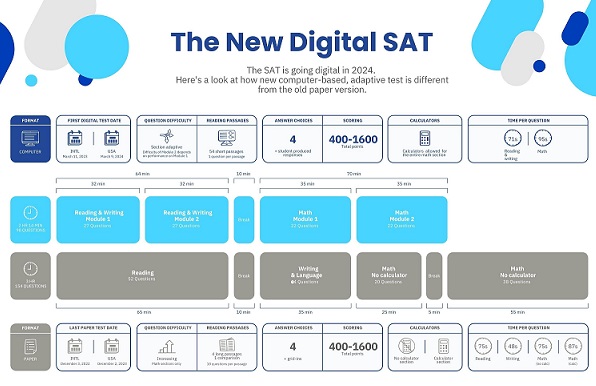Introduction
In today’s fast-paced digital world, educational institutions are making strides to ensure that their assessment methods evolve alongside technological advancements. One such transformation is the shift from the traditional paper-based SAT to the Digital SAT, which is a more modern, streamlined, and secure method of testing. While the Digital SAT has sparked curiosity and debate among students, educators, and institutions, this blog will dive into the indirect implications of this change, including its impact on test preparation, its potential to level the playing field, and the rise of AI-driven tools to boost scores.
Embracing the Digital Landscape in Education
The introduction of the Digital SAT is a testament to how education is aligning itself with the digital age. It presents a testing experience that not only reflects the way students learn today but also offers flexibility in terms of how they engage with content. But the shift to digital goes beyond convenience; it represents a step towards fostering accessibility, reducing logistical challenges, and enhancing the overall user experience. This change comes with adaptive testing, which tailors questions based on the test taker’s performance—creating a more personalized and effective assessment.
With this evolution, the question arises: What does the future of testing look like? Beyond the Digital SAT, we can expect other forms of testing to adapt similar models, embracing technology to improve accuracy and fairness. Additionally, students are no longer limited to traditional study resources but can now access AI-powered platforms like LearnQ.ai to guide them toward success.
Indirect Impacts of the Digital SAT on Students and Educators
The transition from paper to digital is not just about the test format; it hints at broader changes in how students approach learning and preparation. The Digital SAT’s adaptive structure means that students who struggle in certain areas are more likely to be assessed on their actual level, rather than face a one-size-fits-all test. This could lead to less anxiety and more confidence in test-taking, as the experience becomes tailored to their strengths and weaknesses.
For educators, the shift brings new opportunities to incorporate digital learning tools into their curriculum. The use of AI-driven test prep platforms—such as those offered by LearnQ.ai—allows educators to track progress, provide personalized learning paths, and focus on areas that require more attention. The convenience of digital learning means students can now engage in test preparation that is interactive, gamified, and even fun, rather than passive or stressful.
How AI is Shaping the Future of Test Preparation
Perhaps one of the most exciting indirect consequences of the Digital SAT is the rise of AI tools designed to help students maximize their scores. Platforms like LearnQ.ai offer personalized study plans, adaptive practice tests, and AI tutors like Mia to guide students throughout their SAT prep journey. These tools not only mimic the actual test format but also use precision algorithms to predict scores with high accuracy.
The AI tutor feature is particularly beneficial in solving doubts 24/7—a major relief for students studying independently. With instant feedback, students can address their weaknesses immediately and adapt their study strategy in real time. Additionally, AI-driven platforms offer gamified learning modules, transforming the SAT prep process into a more engaging experience that motivates students to stick with their study schedules.
The Broader Significance of Digital Testing in the Post-Pandemic Era
The shift to digital exams represents a broader trend in education that has been accelerated by the COVID-19 pandemic. Remote learning, online assessments, and virtual classrooms became the norm during the pandemic, forcing institutions to rethink how tests like the SAT could be delivered in more adaptable formats. The Digital SAT is an extension of this trend, offering greater flexibility for students who may have different needs based on their learning environments.
One might wonder whether other standardized tests, such as the ACT or GRE, will soon follow suit, adopting similar digital models. The success of the Digital SAT could signal a future where most, if not all, standardized tests are administered online, offering a smoother, more scalable process for students and testing bodies alike.
The Role of Data Analytics in Digital SAT Preparation
A crucial but often overlooked advantage of AI-powered platforms like LearnQ.ai is the integration of data analytics in the test prep process. By analyzing performance across various practice tests, these platforms generate insights into students’ learning patterns, time management, and progress. This data allows students to make informed decisions on where to focus their efforts, making their preparation more targeted and effective.
Data analytics in education has the potential to transform not only how students prepare for exams but also how they are assessed. As we move further into a data-driven educational landscape, test preparation platforms will continue to leverage insights to improve students’ outcomes, fostering smarter, more efficient study practices.
The Future of College Admissions in a Digital World
With the Digital SAT leading the charge, one can’t help but speculate about the future of college admissions. As testing becomes more adaptive and personalized, it may also lead to a shift in how colleges view standardized test scores. Will schools place more emphasis on other factors, such as essays, extracurriculars, and personal interviews? Or will the digital nature of these tests make them a more reliable and consistent indicator of a student’s academic capabilities?
Moreover, with the rise of AI-powered educational tools, college admissions offices may begin to value the ability of students to navigate and utilize these digital resources. This could be particularly important for students from underrepresented communities, as digital test prep platforms offer an affordable and accessible way to prepare for the SAT.
Conclusion
As education continues to evolve alongside technological advancements, the Digital SAT is just one step in a broader transformation that is set to reshape how students prepare for and take standardized tests. From the rise of AI-driven test preparation platforms to the increasing importance of data analytics in education, this shift is more than just a change in format; it represents a new era in how students engage with learning.
The future is undoubtedly digital, and for those preparing for the SAT, the Digital SAT is the perfect example of how technology can be harnessed to make education more efficient, personalized, and accessible.










